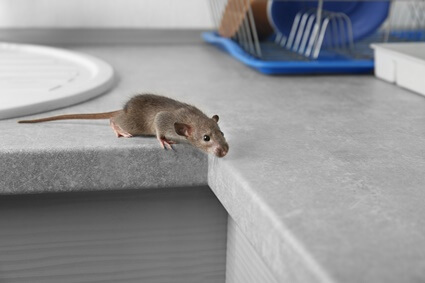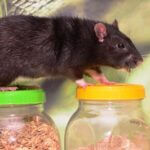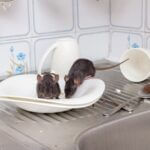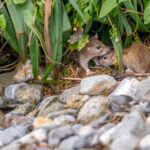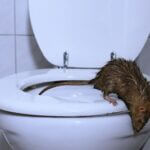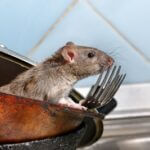Rats target dirty, unkempt spaces with plentiful food, water, and warmth.
This can confuse you if you have a clean home, but rats can still be drawn to these homes. Rats are opportunistic pests, and attracting their attention doesn’t take much.
Rats may come to your home if they can access foods like cereals, meats, fruits, nuts, or berries.
Heat sources like gaming systems, ovens, and central heating draw them in as they provide warmth and comfort. Papers, clutter, insulation, and houseplants make attractive nest-building materials.
Electrical wires are fun to chew, easy to make into nesting materials, and warm to rest in. Unsecured garbage cans and overgrown outdoor plants are all enticing.
Why Do Rats Come in the House?
Rats are hardwired to seek creature comforts. So, they’re always looking for food, water, and shelter. They must find warm areas to set up nests, birth their pups, and raise them safely.
Rats are naturally attracted to human settlements, allowing them to enjoy the warmth and comfort lacking outdoors, especially during the winter.
What Attracts Rats To Your House?
Rats are attracted to many things, but specific factors that can attract rats can be found in any home. If you have a rat infestation, identifying these factors can enable you to eradicate these pests.
Poor Hygiene
You need to assess your home’s hygiene standards.
Rats are drawn to environments that are dirty and unkempt. Rats are more likely to enter if your property is littered with food wrappings, empty cans, and other household trash.
Proper garbage disposal and regular cleaning will discourage rats from nesting in your home. When cleaning, wipe kitchen counter surfaces to remove food crumbs that may be luring these pests in.
Easy Access
Rats are also likely to enter your home if the structural integrity has been compromised.
For instance, if your walls have holes and crevices, rats can easily squeeze through these openings and gain entry into your home.
You can remedy this by sealing all holes and cracks in your walls, roof, and ceiling. Use rat-resistant materials, such as solid concrete or steel wool.
Alternatively, smear a homemade rat repellent, such as peppermint oil or citronella, in rat holes and openings. The pungent smell from these natural extracts will discourage rats from nesting in your home.
Water Sources
Faulty plumbing and broken water pipes can attract rats since they’re a reliable water supply. Repairing worn-out and leaky pipes will make them more resilient against rats and cut off their water source.
If you have pets like dogs or cats, keep their water bowls away at night. This will deny them an alternative water source, thus forcing them to look elsewhere.
Pet Water Bowls
The presence of pet water bowls in your home may attract rats. It guarantees an adequate water supply. Put your dog’s bowl away at night to discourage rats that may be on the prowl for sources of water.
Trees and Bushes
Trees and bushes are attractive to rats because they provide secure spots to hide from predators. It’s not uncommon for rats to build nests on top of trees and inside bushes.
Furthermore, tree overgrowths extending over your roof provide a platform for gaining access to the roof or attic. To mitigate this, you should trim the trees and bushes in your yard.
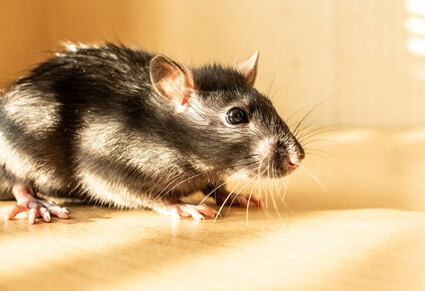
Poorly Stored Food
As highlighted, rats are drawn to people’s homes primarily for food, shelter, and water.
If you have food lying around unattended in your kitchen, rats can pick up the smell and sneak into your home to have their fill.
Ensure all your meats are wrapped and refrigerated. If you have any seeds and cereals in your pantry, store them in glass jars. Seal them tightly with lids to prevent access.
Cereals
Rats love cereals because they’re high in fiber.
Rats can hold onto pieces while nibbling and feast on a large quantity before getting full. Even if you disturb a rat, it can get several grains to store and eat later.
If you keep oats and corn in your pantry, you must ensure they’re stored in glass containers. Guarantee that they’re sealed to prevent rats from accessing them.
Meats
Rats will eat any food. However, rats are omnivores, meaning they can also consume animal protein. Protein-rich foods are good for their health because they’re filling, tasty, and aromatic.
Red meat, chicken, and fish will get the attention of rats, as they can pick up on the smell. Always keep meats refrigerated so that rats cannot contaminate them.
Fruits And Berries
Rats love sweet treats such as fruits and berries, often foraging for them in the wild. If you have these in your house, rats will likely come around your property in search of them.
Worse yet, fruits and berries often have powerful smells, which rats can detect from several yards away. Leaving fruit out on the counter, especially when over-ripe, can draw rats in from outside.
Nuts
According to Nutrient Requirements of Laboratory Animals, rats consume food depending on their energy requirements.
For most wild rats, nuts are an essential part of their diet. They supply a high amount of energy needed to seek out shelter and other sources of food.
Some nuts that rats love include:
- Almonds.
- Peanuts.
- Walnuts.
Rats will come if you leave these foods in your kitchen or on the floor. Since rodents love nuts, many homeowners use them as bait when setting rat traps.
Pet Food
Rats can eat anything as long as it is made of plant or animal material. Pet food is no exception. Leaving your pet’s food in the open overnight provides a convenient food source.
Keep any leftovers away during the night to deter rats from eating them. Additionally, store your pet’s food in containers rats can’t chew through.
Birdseed
Rats eat various types of birdseed. The tiny seeds and larger grains are nutritious, easy to chew, and simple to hide. Any birdseed scattered around your home may attract rats to your property.
If you own a bird that regularly flings seed out of its bowl, you should vacuum the mess regularly.
Clothing
Rats love cluttered areas since they guarantee safety from predators, such as cats and dogs. If you have a pile of clothes lying around, it is easy for a rat to hide there for a long time without being detected.
Heat Sources
Rats need a warm environment to build nests and bring up their offspring. Since people’s homes have heating systems, rats are drawn to them.
They can also find heat sources against:
- Small electric heaters.
- Gaming systems.
- Computers.
- Appliances like washers and dryers.
- Refrigerators.
- Dishwashers.
Even the underside of your warm oven can be a great hiding place for rats. In the winter, rats often enter people’s homes to shelter from the cold weather.
Paper And Books
Paper-based materials are fodder for rats, who can chew through them with their long, sharp teeth.
Paper fiber can be a food source, fun to play with, and valuable for nest-building. Storing books and other paper materials in lidded boxes can protect them from being damaged by rats.
Leaking Pipes and Faucets
Faucets and leaking pipes in homes are enticing to rats. They offer a supply of water. Repairing pipes and hoses cuts this water supply and discourages rats from nesting in your home.
Indoor Plants and other Vegetation
Since rats feed on many things, including seeds and flowers, having indoor plants in your home can draw attention from these rodents. They consume these plants for food and use them for nesting material.
Outdoor Plant Overgrowth
Rats dislike open spaces where predators can easily spot them.
Instead, they like to build nests in overgrowths since they serve as protection from predators. Failing to trim down and groom your yard might give rats a safe hiding spot.
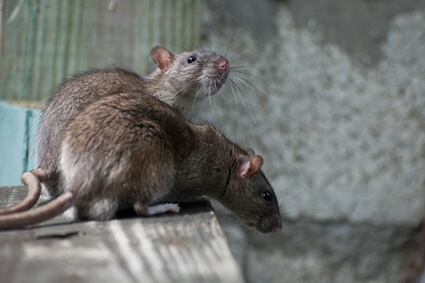
Clutter
Cluttered areas attract rats, allowing them to hide from predators like cats and ferrets. Furthermore, clutter provides material for building nests.
You should pick up clothing, tidy the paper, remove the trash, and rearrange storage boxes. You can also check over storage areas regularly to break up nests and disturb any rats sniffing around.
Pet Waste
According to the Institute of Environmental Toxicology, rats practice coprophagy.
This translates to eating feces, both their own and the poop of other creatures. If you keep a pet, its digestive waste may be a source of extra nutrition for rats, thus luring them to your property.
Unsecured Garbage Cans
Leaving your garbage can unsecured can attract rats. They’ll pick up on the smell of food waste. To prevent this, you must ensure your garbage cans are emptied regularly and sealed tightly with a lid.
Insulation
Insulation composed of foam boards and fiberglass is attractive to rats. They may have edible fibers and conduct warmth, making them a prime nesting spot.
Rats often burrow through the home’s walls and attic insulation to build their nests. These tunnels can also be a great place to rest, store food, and travel to create foraging paths.
Cracks and Crevices on Walls
Homes with holes and cracks in the walls are particularly tempting for rats. They offer easy access. This is why sealing all entry points is essential for preventing rat infestations.
Electrical Wires
Rats are attracted to electrical wires. They are round and easy for rats to grasp when chewing. Rodents mainly chew wires to grind down their teeth. They also use bits of chewed-up wires to build their nests.
Even if the rats aren’t chewing, they may still hunker down around electrical wire conduits, as they provide a secure place to hide from predators.
Keeping your home tidy and getting rid of clutter reduces potential nesting areas for rats. It also denies them materials that they would otherwise use for nest building.

